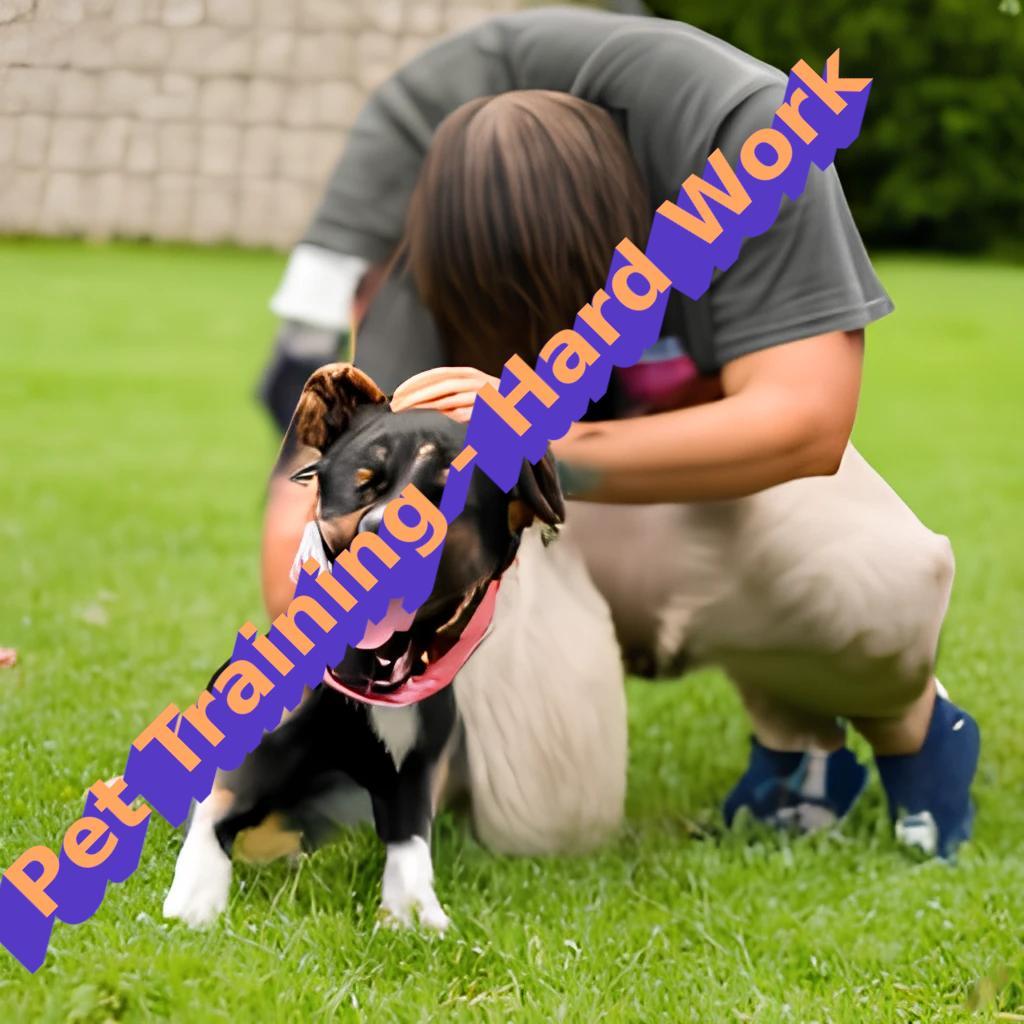


Training your pet is a rewarding journey that strengthens the bond between you and your furry companion. Whether you've just brought home a new puppy or adopted an adult dog, training is essential for a harmonious and happy relationship. In this comprehensive guide, we'll explore the benefits of pet training, offer insights into effective training methods, and provide practical tips for creating a well-behaved and contented pet.
The Benefits of Pet Training.
Strengthening the Human-Animal Bond:
Training sessions provide opportunities for positive interaction between you and your pet, fostering a strong bond built on trust and communication. A well-trained pet is more likely to feel secure and connected to its owner.
Ensuring Safety and Well-being:
Training is crucial for the safety of your pet and those around them. Basic commands like "sit," "stay," and "come" can prevent accidents and keep your pet out of potentially dangerous situations. Behavioral training also helps address issues like excessive barking, chewing, or aggression.
Promoting Mental Stimulation:
Engaging in training exercises stimulates your pet's mind, preventing boredom and the development of destructive behaviors. Mental stimulation is as important as physical exercise for a pet's overall well-being, contributing to a happy and fulfilled life.
Effective Pet Training Methods.
Positive Reinforcement:
Positive reinforcement is a cornerstone of effective pet training. Reward your pet with treats, praise, or playtime when they exhibit desired behaviors. This method encourages your pet to repeat those behaviors and strengthens the association between good behavior and positive outcomes.
Consistency and Repetition:
Consistency is key in pet training. Use the same commands and gestures consistently, and reward or correct behaviors immediately. Repetition helps reinforce the training, making it easier for your pet to understand and respond appropriately.
Patience and Understanding:
Patience is a virtue in pet training. Understand that learning takes time, and pets may not grasp commands immediately. Be patient, stay calm, and adjust your training approach based on your pet's individual personality and learning pace.
Practical Tips for Successful Pet Training.
Start Early:
Early training is essential, especially for puppies. Begin with basic commands and gradually introduce more advanced training as your pet matures. Early training sets a foundation for lifelong obedience and good behavior.
Use High-Value Treats:
Choose treats that your pet finds irresistible as rewards during training sessions. High-value treats create positive associations with training and motivate your pet to actively participate. Use treats sparingly to avoid overfeeding.
Seek Professional Help When Needed:
If you encounter challenges in training or behavioral issues that seem difficult to address, consider seeking professional help. Professional dog trainers or behaviorists can provide guidance, identify the root causes of issues, and offer tailored solutions for your pet.
Pet training can be classified into several categories based on the type of training and the goals of the training. Here are some of the main classifications of pet training:
Obedience training: Obedience training teaches pets basic commands such as sit, stay, come, and heel. This type of training is important for establishing control over your pet and ensuring their safety.
Behavior modification training: Behavior modification training addresses problem behaviors in pets, such as excessive barking, aggression, or destructive behavior. This type of training focuses on changing the underlying behaviors that lead to the problem behavior.
Socialization training: Socialization training exposes pets to different people, animals, and environments to help them learn appropriate social skills and behavior. This is important for preventing fear, anxiety, and aggression in pets.
Agility training: Agility training is a type of training that involves teaching pets to navigate obstacle courses, typically for competition or sport. This type of training can improve a pet's physical health and mental stimulation.
Service animal training: Service animal training involves teaching pets to perform specific tasks to assist individuals with disabilities. This type of training can include tasks such as opening doors, alerting to medical issues, or retrieving items.
Therapy animal training: Therapy animal training involves teaching pets to provide emotional support and comfort to individuals in hospitals, nursing homes, schools, and other settings. This type of training requires pets to have a calm temperament and be comfortable around people.
Pet training can involve several aspects, including obedience training, behavior modification, socialization, and specialized training for service animals or therapy animals. Here are some main points for pet owners to keep in mind when it comes to pet training:
Consistency: Consistency is key in pet training. Pets need clear, consistent signals and commands to learn what is expected of them.
Positive reinforcement: Positive reinforcement is an effective training method that involves rewarding good behavior with treats, praise, or affection. This type of training can help build trust and strengthen the bond between pets and their owners.
Patience: Training takes time and patience. Owners should not expect their pets to learn everything immediately and should be prepared to work on training over a period of weeks or months.
Proper equipment: Owners should ensure that they have the proper equipment for their pets, such as leashes, collars, and harnesses. Training tools such as clickers or training treats can also be helpful.
Professional help: If owners are struggling with pet training, they should consider seeking the help of a professional trainer. Trainers can provide guidance and support to help owners and pets achieve their training goals.
Continued training: Even after pets have learned basic obedience commands, continued training is important to reinforce good behavior and prevent problem behaviors from emerging.
Here's an example of how to train a dog using positive reinforcement:
Choose a command: Decide on a simple command, such as "sit."
Reward good behavior: When your dog naturally sits down, immediately give them a treat and praise them with positive words like "good boy/girl" or "well done!"
Repeat the command: Say the command "sit" before giving the reward. Repeat this process several times until the dog associates the command with the behavior.
Practice: Repeat the command in different locations and at different times to help the dog generalize the behavior.
Wean off treats: Once the dog has learned the behavior, gradually reduce the frequency of treats, and use praise and affection as the reward instead.
Reinforce good behavior: Continue to reinforce good behavior with praise, affection, and occasional treats.
It's important to note that dog training is a process that requires patience and consistency. It's also essential to use positive reinforcement methods to encourage good behavior rather than punishment or negative reinforcement, which can harm the dog and damage the trust between the owner and the pet.
Pet training services can be found in various forms, including:
In-person training: This is the most common form of pet training, where pet owners bring their pets to a trainer for training sessions. These sessions can be group classes or individual sessions, and they may be held in a training facility, park, or other outdoor areas.
Online training: With the rise of technology, online training has become a popular option for pet owners who prefer to train their pets from home. Online training sessions are conducted over video conferencing platforms or pre-recorded videos, and pet owners can follow along with the training exercises and techniques.
In-home training: Some trainers offer in-home training sessions where they come to the pet owner's home to train their pets. This can be helpful for pets who are anxious in unfamiliar settings.
Board and train: Board and train programs involve sending pets to a trainer for an extended period, typically several weeks or months. During this time, the pet receives intensive training and socialization in a controlled environment.
Group classes: Group classes are a popular option for socializing pets and teaching them basic obedience commands. These classes typically involve several pets and their owners, and they can be a fun way for pets to interact with other animals.
When choosing a pet training service, it's important to research the options available and select a trainer or program that aligns with your pet's needs and training goals. Additionally, it's important to choose a trainer who uses positive reinforcement training methods and has experience working with your pet's specific breed and temperament.
Effective pet training is a journey that requires patience, consistency, and positive reinforcement. The benefits extend beyond a well-behaved pet to a strengthened human-animal bond, improved safety, and enhanced mental stimulation for your furry friend. By incorporating positive training methods, staying consistent, and seeking professional assistance when needed, you can create a positive and enriching training experience for both you and your pet. Remember, training is not only about obedience but also about building a trusting and loving relationship with your paw-some companion.
All the best,

We use cookies
We use cookies and other tracking technologies to improve your browsing experience on our website, to show you personalized content and targeted ads, to analyze our website traffic, and to understand where our visitors are coming from. Privacy Policy.